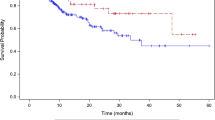Purpose:
To evaluate efficacy and toxicity of hypofractionated stereotactic radiotherapy (hfSRT) with three different dose concepts for irresectable brain metastases not amenable to radiosurgery (SRS) using non-invasive fixation of the skull.
Patients and Methods:
From 6/2000 to 6/2005, 150 patients with 228 brain metastases were treated at the dedicated stereotactic radiosurgery system Novalis™ (BrainLAB, Feldkirchen, Germany) in two German treatment centers. Three different dose concepts were applied: 5 x 6–7 Gy (A: 72 brain metastases), 10 x 4 Gy (B: 59 brain metastases) and 7 x 5 Gy (C: 97 brain metastases). Median planning target volume (PTV) was 6.1 cm3 (range, 0.02–95.97).
Results:
Rates of complete remission (CR), partial remission (PR), no change (NC) and progressive disease (PD) were 42%, 30%, 21% and 7%, respectively (median follow-up 28 months). Median survival was 16 months. Survival at 6 and 12 months was 83% and 66%, respectively. Side effects were dependent on the PTV and on dose concept (median PTV in case of increasing edema or necrosis: 17 cm3, A: 22%, C: 7%). HfSRT with 10 x 4 Gy (B) was well tolerated without side effects.
Conclusion:
Hypofractionated stereotactic radiotherapy is an effective and safe treatment. In case of brain metastases > 15 cm3 (diameter > 3 cm) and concerning toxicity, 10 x 4 Gy seem to be more advantageous than shorter fractionation with higher doses while 5 x 6–7 Gy and 7 x 5 Gy were followed by higher response rates. Further specification of tolerance doses and tolerance according to the different brain regions has to be done.
Ziel:
Vergleich des Ansprechens und der Toxizität nach hypofraktionierter stereotaktischer Radiotherapie (hfSRT) in Maskenfixierung nicht resektabler und nicht für die Radiochirurgie (SRS) geeigneter Hirnmetastasen mit drei verschiedenen Dosiskonzepten.
Patienten und Methodik:
Von 6/2000 bis 6/2005 wurden 150 Patienten mit Hirnmetastasen mit dem Novalis™ System (Brain-LAB, Feldkirchen, Deutschland) in zwei deutschen Kliniken mittels hfSRT behandelt. Die Dosiskonzepte waren: 5 x 6–7 Gy (A: 72 Hirnmetastasen), 10 x 4 Gy (B: 59 Hirnmetastasen) und 7 x 5 Gy (C: 97 Hirnmetastasen). Das mediane Planungszielvolumen (PTV) war 6,1 cm3 (0,02–95,97).
Ergebnisse:
Komplette Remissionen (CR), partielle Remissionen (PR), keine Änderung (NC) and progressive Erkrankung (PD) traten bei 42%, 30%, 21% und 7% auf (medianes Follow-up 28 Monate). Das mediane Überleben betrug 16 Monate (Überleben nach 6 und 12 Monaten 83% und 66%). Die Nebenwirkungsrate (Ödemzunahme, Nekrose) war vom Zielvolumen und Dosiskonzept abhängig (medianes PTV bei Zunahme von Ödem oder Nekrosen: 17 cm³; A: 22%, C: 7% Nebenwirkungen). Die hfSRT mit 10 x 4 Gy (B) führte zu keinen Nebenwirkungen.
Schlussfolgerung:
Bei Hirnmetastasen > 15 cm3 (Durchmesser > 3 cm) bieten 10 x 4 Gy ein besseres Toxizitätsprofil als 5 x 6–7 Gy und 7 x 5 Gy. Die höheren Dosen erzielen allerdings etwas bessere Ansprechraten. Eine weitere Spezifikation von Toleranzdosen, auch bezogen auf die unterschiedlichen Hirnareale, wird angestrebt.
Similar content being viewed by others
Author information
Authors and Affiliations
Corresponding author
Rights and permissions
About this article
Cite this article
Fahrig, A., Ganslandt, O., Lambrecht, U. et al. Hypofractionated Stereotactic Radiotherapy for Brain Metastases. Strahlenther Onkol 183, 625–630 (2007). https://doi.org/10.1007/s00066-007-1714-1
Received:
Accepted:
Issue Date:
DOI: https://doi.org/10.1007/s00066-007-1714-1




